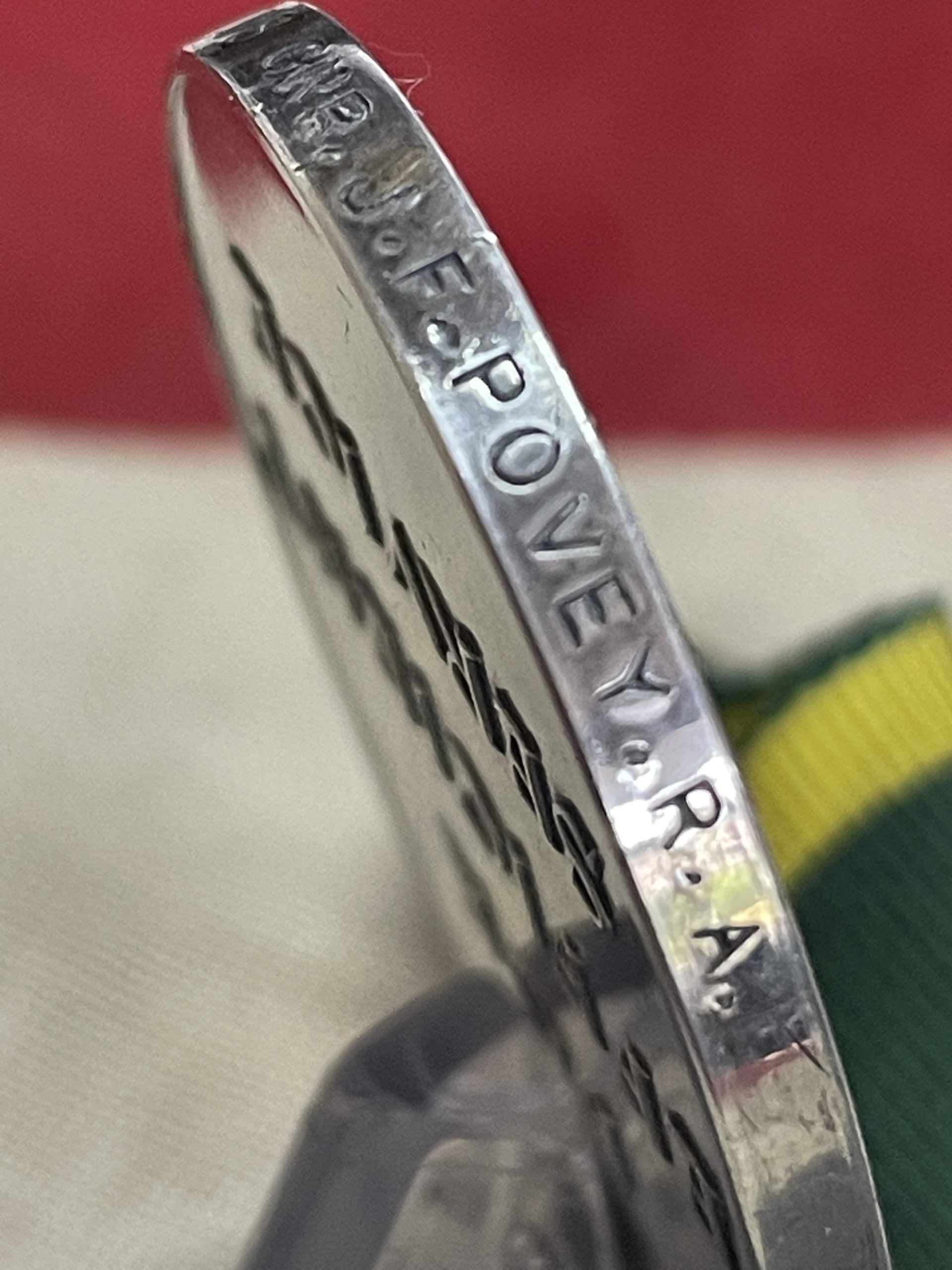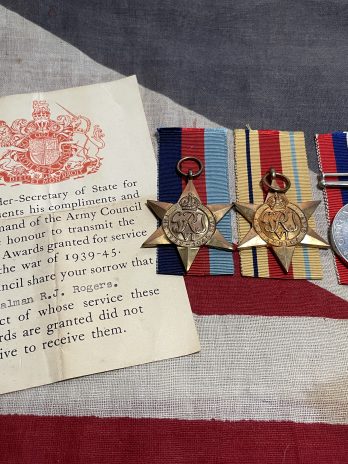TEM correctly named 854108 Gnr JF Povey RA. WWII medals unnamed as issued.
John Francis Povey was born in Woolwich in 1918 to John & Elsie Maud Povey.
He enlisted into the 92nd (5th London) Field Regiment RA in February 1936. It is to be noted that the 92nd were the first troops to land in France in September 1939 and the last to be extracted from Belgium in June 1940, many were rescued at Dunkirk.
John however did not see service in France at the start of the War and his War began in India, then to Africa as part of the 5th Division (8th Army)
Home Defence
While reforming after Dunkirk, 5th Division was posted to Scottish Command, with 92nd Fd Rgt assembling at Fintray in Aberdeenshire. On 29 October 1940 the division moved down to Lancashire to join III Corps in Western Command, where it stayed (except for a month in Northern Ireland in April 1941) until 1942. The field regiments were re-equipped with whatever guns were available until sufficient 25-pounders were ready. It was only in October 1940 that the RA was producing enough battery staffs to begin the process of changing regiments from a two-battery to a three-battery organisation. (Three 8-gun batteries were easier to handle, and it meant that each infantry battalion in a brigade could be closely associated with its own battery.) 92nd Field Rgt formed 467 Bty on 17 January 1941 while it was stationed at Rochdale.
India and Persia
In January 1942 5th Division passed under direct War Office control preparatory to embarking for India in March. While part of the division was diverted for the invasion of Vichy French-controlled Madagascar, 92nd Fd Rgt and the rest of the division arrived in Bombay on 21 May. After concentrating, the division moved across India to Ranchi (the base area for the Burma Campaign). However, after less than three months in India, 5th Division was diverted again, this time to Persia, which was threatened by the German advance on the Caucasus. The division embarked for Basra and proceeded by road via Baghdad into Persia, where it spent the winter near Teheran. The threat to Persia having been diverted by the Battle of Stalingrad, 5th Division was next earmarked as an assault division for the Allied invasion of Sicily (Operation Husky). It proceeded via Baghdad and Damascus where it trained for amphibious landings and mountain warfare. It moved to the Suez Canal zone of Egypt in June, and embarked on 5 July.
Sicily
The division landed in Sicily on 10 July 1943, and together with 50th Division advanced up the east coast to the plain of Catania, where they ran into stiffer opposition. On 13 July a Commando and paratroop attack (Operation Fustian) seized Primosole Bridge over the Simeto river and prevented its demolition, but was unable to retain possession of the bridge. 50th Division was tasked with seizing a bridgehead and 92nd Fd Rgt was among the six regiments of field guns gathered to support the attack. Three battalions of the Durham Light Infantry attacked at 01.00 on 17 July after the massed guns had fired concentrations for half an hour before zero, and the guns continued with barrages and some concentrations once the fighting began. The whole fire programme was restricted by the availability of only a single observation post (OP) that could see the fighting going on in the undergrowth on the far bank of the Simeto. A limited bridgehead was achieved, but it proved impossible to push through it until Catania and Mt Etna were outflanked by other formations.
5th Division remained under fire from the foothills until Eighth Army’s flanking forces caused a German withdrawal that saw the division ‘chasing his troops round the slopes of Mount Etna’. At this stage, 5th Division was withdrawn from the fighting to prepare for the invasion of mainland Italy (Operation Baytown).
Italy
5th Division landed at Reggio di Calabria on 3 September 1943, covered by artillery fire from the opposite side of the Straits of Messina, and then advanced up the coast road to meet US Fifth Army. There was little opposition apart from demolitions and rearguard actions. Fifth Army then advanced up Italy, with 5th Division in the Apennines where the gunners’ training in mountain warfare paid off. The division’s advance was halted at Rionero when the Allies were held up at Monte Cassino and a succession of defended river lines.
During this winter stalemate, 5th Division was transferred to the east coast to assist the Canadians at Ortona and New Zealanders at Orsogna. These attacks were only moderately successful, so 5th Division was switched again, back to the west coast to cross the mouth of the Garigliano and outflank Cassino. The division’s ‘silent’ assault crossing (without artillery fire) on the night of 17/18 January 1944 using beach landing techniques was successful in establishing a firm bridgehead that was held against enemy counter-attacks with the support of the guns, but without further troops it was impossible to advance further. The field regiments had to occupy positions in full view of enemy OPs and suffered a number of casualties.
In March the division was sent to Anzio to relieve another division, and held a section of the line in a trench warfare stalemate that matched World War I, with the same kind of defensive fire tasks, counter-battery fire and barrages for local attacks or counter-attacks. The war became mobile again after the capture of Cassino in May 1944, and 5th Division followed the retreating Germans as far as the Tiber before it was withdrawn for rest.
North West Europe
5th Division handed over its guns and equipment to the newly arrived 46th Division and embarked for Egypt. After a period of rest and reorganisation, followed by internal security duty in Palestine from July 1944 to February 1945, 5th Division was chosen for Operation Goldflake whereby troops from the Mediterranean theatre were transferred to reinforce 21st Army Group fighting in the final stages of the campaign in North West Europe. The division began to arrive at Taranto in Italy in mid-February and then re-embarked at Naples to be shipped to Marseilles on 8 March. It was concentrated near Ghent by 19 March.
The division had not re-equipped in time for the Crossing of the Rhine, but took part in a number of actions in the pursuit to the Elbe. During the assault crossing of that river on 29 April, 92nd Fd Rgt and the rest of the divisional artillery fired in support of 15th (Scottish) Division – the last set-piece bombardment of the war – and then 5th Division passed through the bridgehead they had secured. By now there was only scattered resistance and thousands of prisoners were collected. Hostilities ended on VE Day.
92nd (5th London) Field Regiment served for a while in the occupation forces in Germany (British Army of the Rhine) until RHQ and the three Btys were placed in suspended animation on 16 March 1946.
John is seen to have been hospitalised 4 times during his service, once in India and three times during his time in Italy.
John had married in 1941 and died in 2000.
All medal have their original silk ribbons.














